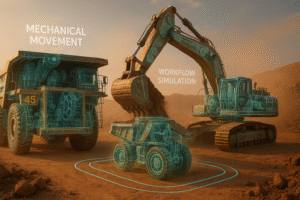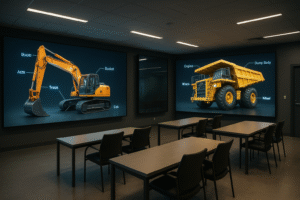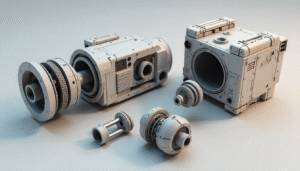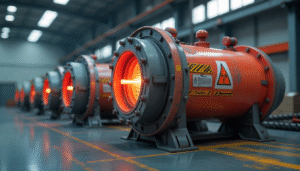Marketing complex industrial products comes with a unique set of challenges. Traditional methods, such as static images, brochures, and lengthy explanations, often fail to communicate intricate details effectively. This is where 3D animation becomes a game-changer. By visually demonstrating how a product works, 3D animation simplifies complexity, enhances engagement, and ultimately drives more sales.
In this article, we’ll explore how 3D animation is revolutionizing industrial marketing, its benefits, and how businesses can implement it effectively.
What Is 3D Animation in Industrial Marketing?
Definition and Key Features
3D animation in industrial marketing refers to the use of computer-generated visuals to create lifelike representations of products, machinery, and processes. Unlike traditional 2D visuals, 3D animations provide depth, movement, and interactivity, making them highly effective for product demonstrations.

Types of 3D Animations Used in Industrial Marketing
- Product Demonstrations – Showcasing functionality in a real-world scenario.
- Explainer Videos – Breaking down technical information into engaging content.
- Training and Instructional Videos – Enhancing learning with immersive visuals.
- Augmented Reality (AR) and Virtual Reality (VR) Applications – Providing interactive experiences.
How 3D Animation Differs from Traditional Marketing Content
Unlike static images or text-heavy presentations, 3D animations allow potential customers to visualize products in action. This not only makes it easier to understand complex mechanisms but also keeps the audience engaged longer, increasing the likelihood of conversion.
The Growing Importance of 3D Animation in B2B Marketing
Industry Trends and Statistics
- Studies show that video content increases engagement and conversion rates by over 80%.
- More than 70% of B2B buyers watch product-related videos before making purchasing decisions.
- The rise of digital transformation has made immersive content a necessity rather than a luxury.
Why Companies Are Investing in 3D Animation
- The shift to digital sales presentations.
- The need for scalable, reusable marketing assets.
- The demand for high-impact visual storytelling.
- The ability to enhance lead generation and conversion rates through engaging content.
Key Benefits of 3D Animation for Industrial Products
Enhances Product Visualization
- Demonstrates intricate details that static images cannot capture.
- Showcases internal components and moving parts.
- Highlights features that differentiate a product from competitors.
Simplifies Complex Concepts
- Converts technical jargon into easy-to-understand visuals.
- Break down complicated processes step by step.
- Allows customers to see a product’s value in a practical, real-world context.
Engages and Retains the Audience’s Attention
- Captures viewers with dynamic motion and high-quality visuals.
- Holds attention longer compared to traditional marketing materials.
- Reduces bounce rates on websites and improves time-on-page metrics.
Saves Time and Cost on Live Demonstrations
- Reduces the need for physical prototypes.
- Allows scalable presentations without logistical constraints.
- Minimizes travel expenses for in-person demonstrations.
Boosts Conversion Rates
- Builds customer confidence through clear and engaging product insights.
- Reduces uncertainty, leading to increased purchase intent.
- Provides a competitive advantage in the sales process.
How 3D Animation Is Used in Industrial Marketing
Product Demonstrations
- Realistic simulations of product usage.
- Virtual walkthroughs for large machinery.
- Illustrating different configurations and customization options.
Explainer Videos
- Highlighting unique selling points through engaging storytelling.
- Comparing product features to competitors effectively.
- Explaining processes like installation, maintenance, or troubleshooting.
Training & Instructional Content
- Interactive training modules for employees and customers.
- Step-by-step assembly and maintenance guides.
- Reducing training costs and increasing learning retention.
Augmented Reality (AR) and Virtual Reality (VR) Integration
- Immersive product experiences through AR/VR applications.
- Real-world case studies of businesses leveraging AR-powered 3D models.
- Enhancing trade show exhibits and customer demonstrations.
How 3D Animation Improves Sales & Marketing Strategies
Enhancing Sales Pitches with Interactive Presentations
- Equipping sales teams with dynamic, visually compelling materials.
- Personalizing client presentations with tailored animations.
- Demonstrating real-time product functionality with interactive elements.
Improving Website and Social Media Engagement
- 3D videos increase website dwell time, reducing bounce rates.
- Higher engagement rates on platforms like LinkedIn and YouTube.
- More shares and interactions compared to text-based content.
Strengthening Brand Identity & Credibility
- Positions the company as an industry leader.
- Builds trust through professional, high-quality visuals.
- Showcases innovation and technical expertise.

Case Studies: How Companies Use 3D Animation to Sell Industrial Products
Case Study 1: Machinery Manufacturer Boosts Conversions with 3D Demos
- How a manufacturing company increased sales by 40% using animated demonstrations.
- The impact of visual storytelling in reducing buyer hesitation.
Case Study 2: B2B Company Generates More Leads with Explainer Videos
- The role of short 3D videos in engaging potential buyers.
- How animation improved lead nurturing and sales funnel efficiency.
Case Study 3: Startup Attracts Investors with AR-Powered 3D Models
- How immersive product visualization secured funding for a tech startup.
- Demonstrating prototypes in AR to potential stakeholders.
Best Practices for Implementing 3D Animation in Your Marketing Strategy
Focus on Storytelling, Not Just Technical Specs
- Engage audiences with a narrative-driven approach.
- Make industrial products relatable through real-world scenarios.
Optimize for Multiple Platforms
- Ensure compatibility across websites, social media, and presentations.
- Use SEO strategies to rank 3D animations on search engines.
- Adapt content for mobile users and different viewing formats.
Choose the Right Animation Style
- Photorealistic vs. stylized animations: Which one suits your brand?
- Consider audience preferences and industry standards.
- Balance detail with clarity to avoid overwhelming the viewer.
Common Mistakes to Avoid in 3D Animation Marketing
- Overloading animations with excessive details.
- Ignoring alignment with overall marketing and sales objectives.
- Failing to optimize for mobile viewing.
- Using animations without a clear call-to-action.
Conclusion
3D animation is transforming industrial marketing by making complex products easier to understand, more engaging, and highly persuasive. By leveraging dynamic visuals, companies can enhance their sales process, improve customer education, and ultimately drive more conversions.
If you’re looking to implement 3D animation in your marketing strategy, now is the time to invest in high-quality visual storytelling. Explore how 3D animation can elevate your brand and help you stand out in the competitive B2B landscape.
FAQs
1. How much does it cost to create a 3D animation for marketing?
Costs vary based on complexity, duration, and animation quality, ranging from $1,000 to $50,000+ per project.
2. What industries benefit the most from 3D animation marketing?
Industries like manufacturing, healthcare, construction, and technology see the highest ROI from 3D animated content.
3. Can 3D animation replace traditional product photography?
While it enhances visualization, 3D animation complements rather than replaces high-quality photography.
4. How long does it take to create a 3D animated product demo?
Production timelines range from 2 weeks to 3 months, depending on project scope.
5. What are the best software tools for creating 3D animations for industrial marketing?
Popular tools include Blender, Autodesk Maya, Cinema 4D, and Adobe After Effects.






